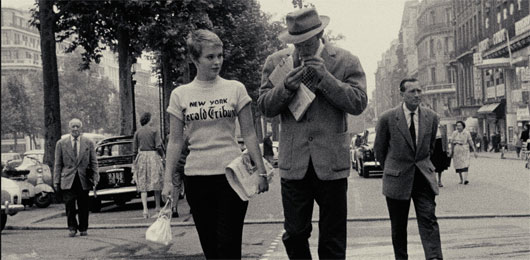 Eli Roth has described this landmark slice of French cinema as cinematic punk rock, which is spot-on. Even 50 years on from its first release its possible to see how this free-spirited homage to film noir, set in a glowing Paris, must have stunned audiences with its improvised feel, loose rhythms and jump-cutting.
Eli Roth has described this landmark slice of French cinema as cinematic punk rock, which is spot-on. Even 50 years on from its first release its possible to see how this free-spirited homage to film noir, set in a glowing Paris, must have stunned audiences with its improvised feel, loose rhythms and jump-cutting.
Plot-wise its classic b-movie noir material our hero, Michel (Belmondo), steals a car and drives from Marseille to Paris to pick up some cash he is owed by a dodgy gangster. En route he shoots a cop, and when he arrives in the capital the police form a constant shadow. There he hooks up with old girlfriend Patricia (a radiant Seberg), and tries to persuade her to sleep with him and that he really loves her. She however doesnt trust him how can she, when he is clearly a petty criminal and a thief, and she has a better offer from a publisher? The rest of the film is pretty much the two of them verbally sparring and running from the police, twice taking refuge in the comforting dark of a Champs Elysees cinema, until the inevitable showdown, which owes as much to the Western as noir. Godard said “All you need for a movie is a gun and a girl,, and here is that movie.
Its really all about the style over any substance, but what a style it is. The original cut was well over two hours, but the final film had to be 90 minutes. Instead of cutting out scenes, as was the usual practise, Godard cut out moments between actions, thus speeding up the action and creating a jerky visual style. It was a huge risk, but it works brilliantly, requiring the audience to fill in the gaps. The shooting of the policeman is a classic example we see the bike approach Michel, a close-up of his gun in his hand, and the cop falling to the ground. All of the action in between any dialogue between the two of them, Michel reaching for the gun, and aiming it is gone, yet the scene still makes sense. It was something of a cinematic breakthrough, and Godard spent the next 30 years trying to refine his new language.
The director also makes great use of his three big stars Belmondo, Seberg and Paris itself. Belmondo is the epitome of 60s cool, fag constantly in mouth, endlessly borrowing money from his friends so he can zip around Paris in a stolen car, staying one step ahead of the cops. Seberg is equally visually iconic the picture of the two of them walking along the Champs Elysees with her in an International Herald Tribune t-shirt is a classic. She is an American trying to become a journalist, using her pixie charm to get noticed. Their relationship is complex and playful it is never really clear who loves whom but always entertaining and ultimately tragic when the inevitable betrayal takes place.
Considering it was made by people who were more interested in film criticism than actually making movie film journal Cahiers du Cinema gets a mention its not surprising Breathless is stuffed with so many homages to cinemas. Belmondo bases his image on Humphrey Bogart, constantly rubbing his lips, he tells Patricia I always fall for the wrong girls, a line from The Maltese Falcon. The ending is very like High Sierra, which was Bogarts first major role.
The cinema itself is a handy hiding place for the two lovers, and dialogue can be heard from Westbound, a 1958 Randolph Scott western, and Whirlpool, a 1949 Otto Premiger film. But the biggest homage is perhaps the story itself, which is very much like They Live By Night, the 1949 Nicholas Ray film noir. The French new wave of filmmakers were trying to overthrow the “Le cinéma du papa” dads cinema and bring in something fresh.
Paris has never looked lovelier there is a stunning shot of the lights coming on in the Champs Elysees on a summers night, and the romantic surrounds can only create a hugely atmospheric setting for the love affair.
Ultimately its tempting to see Breathless as a fluke moment in time, when the planets were aligned. Certainly Seberg and Godard never hit the same heights again Seberg had a long, slow, tragic decline and a suicidal end, while Godard became embroiled in politics and obsessed with challenging mainstream cinema, and basically made ever-more unwatchable films. He became an aloof, didactic bore. Here though his loose style of filmmaking works a treat some days he would refuse to work because he was uninspired, some days the actors would have few lines and would have to improvise. Somehow the tributes to b-movies, the story and acting styles all converge to create one of the really iconic moments of Nouvelle Vague French cinema. Writer Francois Truffaut and Godard never worked together again, in fact the film damaged their relationship irreparably, and Godard went on to have bust-ups with almost every major French writer and star. Yet despite all this, Breathless works.
Overall Verdict: Wonderfully spontaneous, fresh, blast of the French New Wave that looks as crisp as it did 50 years ago.
Reviewer: Mike Martin